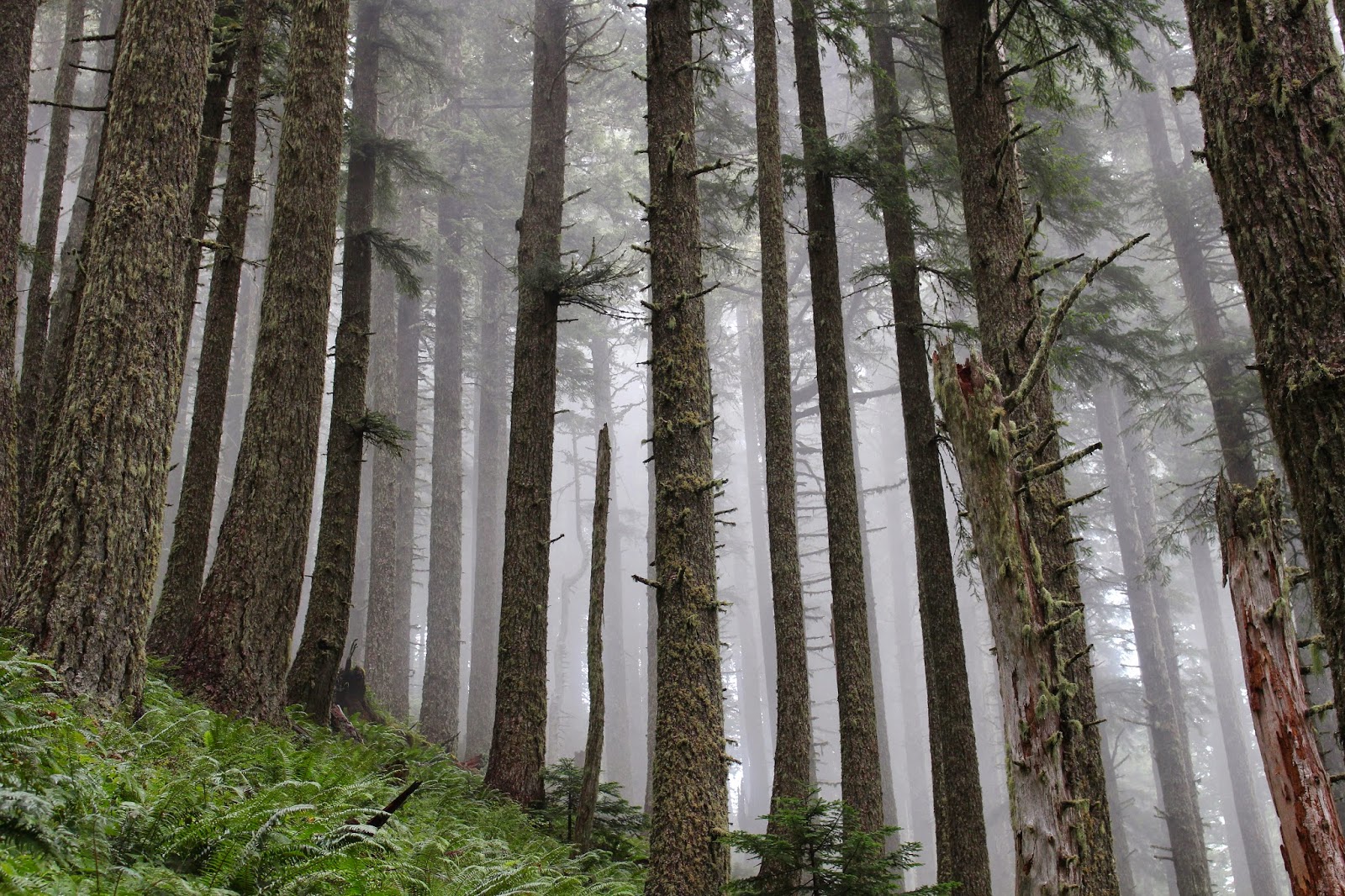It's been hot lately in Roseburg and I've been asking the weather gods to send us some cool weather and rain. So my pleas have been heeded and as I got soaked by the occasional rain shower and the wet vegetation encroaching the trail, I began pleading for another heatwave. Some people just can't be pleased. The response to my plea for heat was a cold wind blowing through my wet clothing on a recent hike to Mary's Peak. Some people just don't get heeded, either.
 |
| Wet and cold columbine |
Mary's Peak tops out at a modest 4,097 feet and while she may be a small peak in the larger scheme of things, Mary does have the honorable distinction of being the highest peak in the Coast Range. Her proximity to Corvallis, Salem, and Eugene ensures she gets a lot of foot traffic and a road rambling round the mountain provides multiple trailheads and distances: the hikes range from the he-man 12.2 miler (2,000 feet of elevation gain), to the namby-pamby 1.2 mile (with a paltry 300 feet of elevation gain) version. I opted for the middle distance hike, but since it gained 1,600 feet anyway, I'm kicking myself a little bit for not doing the he-man hike.
 |
| Forest on Mary's Peak |
As I laced up my boots at the Connors Camp trailhead, the soft hiss of rainfall permeated the forest. The top of Mary's Peak was hidden in the clouds and I crossed my fingers, hoping the clouds would clear as the day wore on. The forest was absolutely lush what with vine maples arching over the trail while salal, ferns, and Oregon grape drooped over the trail, making sure my legs got wet. As previously stated, Mary's Peak sees a lot of use but on a rainy mid-week day, not so much; I ran into only two other hikers on the trail and pretty much had the entire mountain to myself.
 |
| "I'll keep an eye out for you, maybe two!" |
Although the trail gained 1,600 feet, the grade was never overwhelming and tendrils of fog wrapped their moist fingers around mossy tree trunks. Occasionally, the cloud cover would momentarily break, the blue sky and bright sun was jarring but the warmth was welcomed by this cold and wet hiker. All the moisture in the air, ground, and vegetation pleased the slugs which were on the trail in slimy sluggishness.
 |
| View from the summit meadow |
The payoff on this hike came about a mile before the summit when the forest abruptly ended and the trail sidehilled across a grassy slope. The clouds were still hanging around but at an elevation higher than the peak. The patchwork farmlands surrounding Philomath and Corvallis were visible, resembling a quilt tossed over the sleeping earth by Mary herself. You are supposed to be able to see the Cascades all the way up to Mount Ranier on a clear day, but I was glad to be able to see as much as I did on this dreary and mostly gray day.
 |
| Incoming cloud |
The actual summit of Mary's Peak was somewhat anticlimactic as it had several microwave relay dishes on top. A trail led away from the electronic gear to the summit meadow and I headed down to the meadow loop trail in search of some extra mileage. After a short walk through a forest comprised of bluish Noble fir, the trail crossed the Mary's Peak Road and now I was confused. Per my map, there should be no road crossing and I had somehow wound up where I originally crossed the road when I neared the summit. In hindsight, I needed to take the trail that was marked "campground" for the meadow tour; oh well, now I'll have to pencil in a return visit.
 |
The summit was all about the meadows
|
Now that I was reoriented, I grabbed the trail leading up and over a grassy hill and dropped down to the observation area. The observation area is as far as one can drive a car and sports a northward viewpoint, a picnic bench, and an overlook of a very large meadow. Of course, when it's cold and wet, the parking lot is bare and bereft of cars and hikers. Still looking for extra miles, I grabbed the trail dropping down to the Tie-in Trail, a trail connecting the North and East Ridge trails.
 |
| Salal flowers |
The trail was predictably lush and if you like the color green, then you'll just love the Tie-in Trail. Even though it was mid-afternoon, the light had darkened considerably, that statement being empirically proven by the fact I had to crank up the ISO settings on my camera. Walking through a wet and lush forest was the sum and total of my existence for the next three miles before arrival back at Connors Camp.
 |
| Green was the color of the day |
This was a neat hike and my first visit to Mary's Peak was most enjoyable. I think next time, I'll do the he-man hike and hopefully it'll be warmer than it was on this day. Oops, there I go again about the weather!





























































